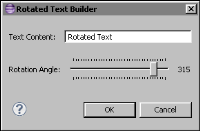The class RotatedTextBuilder extends the org.eclipse.birt.report.designer.ui.extensions.IReportItemBuilderUI interface. The code is in
Listing 23‑18.
The code instantiates an object of RotatedTextEditor class to populate the actual UI. The code of the RotatedTextEditor class is in
Listing 23‑19.
class RotatedTextEditor extends TrayDialog
{
protected RotatedTextItem textItem;
protected Text txtText;
protected Scale sclAngle;
protected Label lbAngle;
protected RotatedTextEditor( Shell shell, RotatedTextItem textItem )
{
super( shell );
this.textItem = textItem;
}
protected void configureShell( Shell newShell )
{
super.configureShell( newShell );
newShell.setText( "Rotated Text Builder" ); //$NON-NLS-1$
}
protected void createTextArea( Composite parent )
{
Label lb = new Label( parent, SWT.None );
lb.setText( "Text Content:" ); //$NON-NLS-1$
txtText = new Text( parent, SWT.BORDER );
GridData gd = new GridData( GridData.FILL_HORIZONTAL );
gd.horizontalSpan = 2;
txtText.setLayoutData( gd );
}
protected Control createDialogArea( Composite parent )
{
Composite composite = new Composite( parent, SWT.NONE );
GridLayout layout = new GridLayout( 3, false );
layout.marginHeight = convertVerticalDLUsToPixels( IDialogConstants.VERTICAL_MARGIN );
layout.marginWidth = convertHorizontalDLUsToPixels( IDialogConstants.HORIZONTAL_MARGIN );
layout.verticalSpacing = convertVerticalDLUsToPixels( IDialogConstants.VERTICAL_SPACING );
layout.horizontalSpacing = convertHorizontalDLUsToPixels( IDialogConstants.HORIZONTAL_SPACING );
composite.setLayout( layout );
composite.setLayoutData(new GridData( GridData.FILL_BOTH ));
createTextArea( composite );
Label lb = new Label( composite, SWT.None );
lb.setText( "Rotation Angle:" ); //$NON-NLS-1$
sclAngle = new Scale( composite, SWT.None );
sclAngle.setLayoutData( new GridData( GridData.FILL_HORIZONTAL ) );
sclAngle.setMinimum( 0 );
sclAngle.setMaximum( 360 );
sclAngle.setIncrement( 10 );
lbAngle = new Label( composite, SWT.None );
GridData gd = new GridData( );
gd.widthHint = 20;
lbAngle.setLayoutData( gd );
sclAngle.addSelectionListener( new SelectionListener( ) {
public void widgetDefaultSelected( SelectionEvent e )
{
lbAngle.setText( String.valueOf( sclAngle.getSelection( ) ) );
}
public void widgetSelected( SelectionEvent e )
{
lbAngle.setText( String.valueOf( sclAngle.getSelection( ) ) );
}
} );
applyDialogFont( composite );
initValues( );
return composite;
}
private void initValues( )
{
txtText.setText( textItem.getText( ) );
sclAngle.setSelection( textItem.getRotationAngle( ) );
lbAngle.setText( String.valueOf(
textItem.getRotationAngle( ) ) );
}
protected void okPressed( )
{
try {
textItem.setText( txtText.getText( ) );
textItem.setRotationAngle( sclAngle.getSelection( ) );
}
catch ( Exception ex ) {
ex.printStackTrace( );
}
super.okPressed( );
}
}
The RotatedText builder UI, as shown in
Figure 23‑28, consists of a Text control and a Scale control, corresponding to the text content and rotation angle properties. The builder appears every time you add a RotatedText item to the layout or double-click a RotatedText item in the layout.

